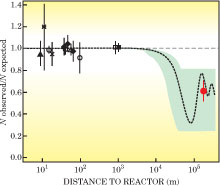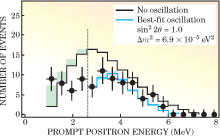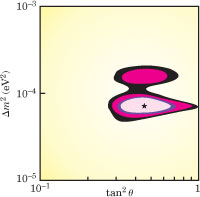| Search and Discovery | |||||||||||||||
|
Antineutrinos From Distant Reactors Simulate the Disappearance of Solar Neutrinos First results from the Kamland detector in Japan home in on the parameters of solar-neutrino flavor oscillation. After 36 years of solar neutrino experiments, the inescapable conclusion is that a large fraction of the electron neutrinos (ne) produced by nuclear processes in the Sun's core are metamorphosing into other neutrino varieties somewhere en route to the detectors on Earth (see Physics Today, December 2002, page 16). The cause is very likely neutrino oscillation, resulting from the existence of three putative neutrino mass eigenstates with three different masses. But until recently, the data have allowed considerable latitude in the oscillation parameters, leaving open a variety of possible mechanisms as the neutrinos traverse solar and terrestrial matter as well as 150 million kilometers of vacuum. Now, however, the first results from Kamland--a new kind of
reactor-neutrino experiment--have dramatically narrowed the range of
possible solar-neutrino parameters and thus made it clear that the
decisive metamorphosis takes place in the Sun itself.1
Kamland, a liquid-scintillator detector deep inside the Kamioka mine in
mountains west of Tokyo, exploits electron antineutrinos (
Oscillating flavors
The three neutrino mass eigenstates are presumed to be different coherent superpositions of the three flavor eigenstates (ne, nm, and nt) associated with the three charged leptons: the electron, the muon, and the tau. There is good evidence that only two of the three mass eigenstates contribute significantly to ne. In that approximation, one can write
P(L) = 1 - A sin2 (L/l)
for the oscillating probability that a neutrino born as a ne is still a ne after a journey of length L through vacuum. The characteristic vacuum oscillation length in kilometers is given by l = E/1.27Dm2, where E is the neutrino's energy in GeV and Dm2 is the difference between the squared masses of the two relevant mass eigenstates in eV2. The amplitude of the probability oscillation is A = sin22q, where the "mixing angle" q is the angle by which the state ne is rotated from the lighter of the two solar-neutrino mass states in the Hilbert space spanned by the mass eigenstates. Because there are, as yet, no data good enough to reveal the very small contribution of the third neutrino mass eigenstate to ne, it is customary to summarize solar-neutrino oscillation results in terms of the two parameters q and Dm2. Prior to the Kamland result, the region of parameter space favored by the existing solar-neutrino data was the so-called large-mixing-angle (LMA) solution, with q ranging from about 25° to 40° and Dm2 near 5 x 10-5 eV2. However, several alternatives to the LMA solution had also
survived the experimental gauntlet with statistically respectable,
albeit larger, chi-squares. Some, like the LMA solution, had large
mixing angles; but they had much smaller Dm2, ranging from 10-7 eV2 all the way down to 5 x 10-12 eV2. Another solution still in play last year gave a q
of only about 1°. So small a mixing angle would suit the theoretical
prejudice that neutrino mixing angles ought not to be much bigger than
those that describe the mixing of quark flavors among the quark-mass
eigenstates. There were also several solutions that The highest energy of neutrinos produced in the solar core is only 20 MeV. The third neutrino mass eigenstate, though it contributes little, if anything, to solar-neutrino oscillation, is important for the well-attested oscillation of GeV muon neutrinos produced in the atmosphere by cosmic rays. For atmospheric nm oscillation, the relevant Dm2 is a few times 10-3 eV2 (see Physics Today, August 1998, page 17).
Twenty-two surrogate Suns
The beta decay of fission fragments in a power reactor
produces a continuous, penetrating flux of electron antineutrinos. The
22 reactor sites in Japan and Korea that contribute significant
in the liquid scintillator. And that reaction can only be accomplished by electron antineutrinos. The energy distribution of the neutrinos recorded by Kamland peaks at about 4 MeV. For a neutrino of that energy, the LMA solution gives an oscillation length l of about 100 km. That's why the Kamland complex is so well suited to probe the LMA region of the parameter space. All of the alternative solutions to the solar-neutrino data have much smaller Dm2 and thus correspondingly longer l. Therefore, only the LMA solution predicts that Kamland will record a significant shortfall of reactor neutrinos. And previous reactor-neutrino detectors, none of which was farther than a kilometer from its source reactor, could only have seen a shortfall if Dm2 were much larger than 10-4 eV2. "When Kamland was first proposed," recalls Stuart Freedman (University of Calfornia, Berkeley), a spokesman for the collaboration's US contingent, "we had a hard time selling it to the community, because most of them were betting on the small-mixing-angle solution, to which Kamland wouldn't be sensitive."
In the first five months of data taking, the Kamland group found a total of 53 The estimated background of only about one event in the final sample of 54 is impressively low by the standards of neutrino detectors in underground settings rife with radioactive contaminants. It points up a considerable advantage of looking for reactor antineutrinos rather than solar neutrinos. Each inverse beta-decay reaction produces not just one, but a correlated pair of signals that makes it much easier to spot spurious events. First, the slowing and annihilation of the positron produces a "prompt" scintillation signal whose intensity provides a measure of the incident neutrino's energy. Then, typically a few hundred microseconds later, the neutron can be captured by a proton to create a deuteron and a telltale 2.2 MeV photon.
Energy spectrum
The Kamland group's best-fit oscillation parameters from the observed shortfall and energy distribution are q = 45° and Dm2 = 6.9 x 10-5 eV2. The 32 events in the plot with prompt energies below 2.6 MeV were excluded from the analysis because, below this cutoff, antineutrinos from radioactive uranium and thorium in Earth's crust contribute significantly to the tally of inverse-beta-decay events. At the 95% confidence level, the Kamland data already exclude all the previously surviving alternatives to the LMA solution. The posting of the first Kamland results on the Web triggered a torrent of analyses by the theorists. (One wag commented that the appearance of five of those papers hours before the Kamland paper constituted evidence of causality violation.) The first order of business was to extract the oscillation parameters from a global fit to all the existing solar-neutrino data together with the Kamland results. A typical fit of this kind, carried out by John Bahcall (Institute for Advanced Study) and coworkers,2 is shown in the lower figure on page 15. "The Kamland results decisively shrink the allowed range of the solar-neutrino parameters," says Bahcall. "And they limit a possible sterile component to less than 9%." The Kamland result is also good evidence that antineutrinos and neutrinos share the same oscillation parameters, as required by fundamental theory. But the theory does allow the neutrino mixing matrix to include a complex phase that might engender a subtle neutrino-antineutrino asymmetry (leptonic CP violation) strong enough to explain the upsetting of the matter-antimatter balance in the early cosmos. (See the article by Helen Quinn in Physics Today, February 2003, page 30.) The triumph of the LMA solution raises the prospect that future long-baseline neutrino experiments may find evidence for leptonic CP violation.
The MSW effect
For neutrinos coming from the solar core, the LMA solution implies that vacuum oscillation on the journey to Earth plays second fiddle to an irreversible flavor change that takes place in high-density regions of the Sun: the Mikheyev-Smirnov-Wolfenstein (MSW) effect. If vacuum oscillation with a l very much shorter than our distance from the Sun were the dominant process, the energy dependence of the solar-neutrino shortfall would be almost completely washed out. But that's not the case; the solar-neutrino detectors do see a clear energy dependence. Because of its association with the electron, a ne passing through matter feels an extra interaction energy, proportional to the ambient electron density, beyond the matter-interaction energy common to all the neutrino flavors. In 1986, Stanislav Mikheyev and Alexei Smirnov at the Institute for Nuclear Research in Moscow, using a formalism developed by Lincoln Wolfenstein (Carnegie Mellon University), pointed out that this extra energy term should produce a flavor metamorphosis when a ne produced in the core passes through a critical-electron-density region of the Sun. The critical density, and thus the distance from the core at which it's encountered, depends on the neutrino's energy. When the neutrino finally emerges from the Sun it is, to good approximation, in a coherent superposition of flavor states that constitutes a mass eigenstate. A pure mass eigenstate would experience no vacuum oscillation on the rest of the journey to Earth. There is now good evidence that this mass eigenstate, the heavier of the two whose splitting is given by Dm2, is roughly an equal superposition of all three neutrino flavors. The MSW mechanism was originally invoked to explain how a small mixing angle might cause a large solar-neutrino shortfall. "I'm sometimes asked whether our first Kamland result is a discovery or just a confirmation of what we already believed," says Giorgio Gratta (Stanford University), the US contingent's other spokesman. "I like to compare it to the first creation of spectral lines in the laboratory in the 19th century. Frauenhofer had already found lines in the solar spectrum. But until they were also made on Earth, one couldn't be sure that they were more than just something that happened only in stars."
Bertram Schwarzschild
1. K. Eguchi et al. (Kamland collaboration), Phys. Rev. Lett. 90, 021802 (2003).
2. J. Bahcall, M. Gonzalez-Garcia, C. Peña-Garay, J. High Energy Phys. 02, 009 (2003).
© 2003 American Institute of Physics
|
|
|
|||||||||||||
|
|||||||||||||||


